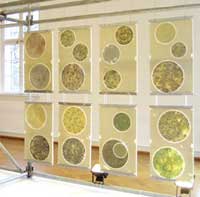Apr 16 2008
Sandwich structures made of different polymeric materials open up a wide range of possibilities for customized products with very diverse properties. Automotive applications may focus on reducing weight while maintaining a high level of stiffness, for example, but the key considerations in the construction sector can be quite different. Bayer MaterialScience, one of the world's leading providers of high-tech materials and solutions, has been working closely with the Hochschule Ostwestfalen-Lippe University of Applied Sciences on the project "Inside Outside - Building with Sandwiches". This project was carried out over the course of just under a year and investigated new sandwich material combinations for interior design. The project examined surfaces, core layers, intermediate layers and the combination of various components according to different design criteria and with a view to their suitability for use in construction applications.
 Sandwich structures made of different polymeric materials open up a wide range of possibilities for customized products with very diverse properties. Automotive applications may focus on reducing weight while maintaining a high level of stiffness, for example, but the key considerations in the construction sector can be quite different.
Sandwich structures made of different polymeric materials open up a wide range of possibilities for customized products with very diverse properties. Automotive applications may focus on reducing weight while maintaining a high level of stiffness, for example, but the key considerations in the construction sector can be quite different.
The project - now completed - focused on various areas including large-area translucent components with a polyurethane foam core and facings made of the transparent polycarbonate MakrolonR. Some of the specimen sandwiches produced in Bayer MaterialScience's polyurethane Technical Service Center have now been displayed as part of a cube at the "Material2Light" exhibition in the Designhaus in Darmstadt and also at the Luminale, part of the "light+building" trade fair in the same town. The sandwiches were produced by positioning circular shapes containing recycling aggregates in the form of colored glass, bast strips, wood fibers and other materials in a rectangular mold. The circles were then fixed in a thin-layer matrix made of polyurethane foam. "The special structure of this foam and the recycling materials give the material a slightly transparent, translucent appearance and a mosaic-like structure reminiscent of a kaleidoscope," says Gerald David, who designed the elements. The areas surrounding the circular shapes were filled with rigid polyurethane foam to form rectangular specimen sandwiches. The transparent MakrolonR sheets for the outside of the elements were sourced from Bayer Sheet Europe GmbH, a fully owned subsidiary of Bayer MaterialScience that uses this high-tech material to manufacture solid and multiwall sheets, and other semi-finished products. Bayer MaterialScience has applied to the German Patent Office for registration of the design under the regulations governing the protection of design patents.
"Our aim was not to show finished, market-ready products at these two exhibitions - we wanted to demonstrate the innovative design possibilities of these materials. As far as interior design is concerned, these materials could be used to create screens in office and administrative buildings, or in the construction of trade fair stands and bus stop shelters," explains Joachim Kleser, construction applications expert in the New Business section of Bayer MaterialScience. "The components offer new opportunities to experiment with material innovation and could prove to be the perfect complement to the current trends of interior and lighting concepts such as translucent concrete, for example," adds Prof. Uta Pottgiesser from the Hochschule Ostwestfalen-Lippe University of Applied Sciences.